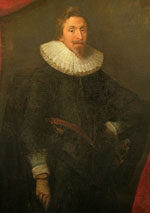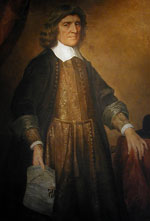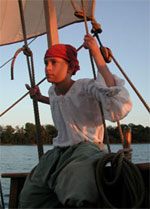  |
|
As a |

Answer:
St. Mary’s City is located in St. Mary’s County, on the western shore of Maryland. It is near the southern tip of a peninsula formed by the Potomac River and the Chesapeake Bay. St. Mary’s City is on the St. Mary’s River, which flows into the Potomac River.

![]()
Answer:
St. Mary’s City was the first capital of Maryland. English colonists founded St. Mary’s City in 1634. The Yaocomaco Indians allowed the English to use their land and houses to start a new colony. This small settlement was the capital of the province of Maryland until 1695, when the capital moved to Annapolis.
Today, Historic St. Mary’s City is a museum of living history and archaeology.Historians and archaeologists work hard to find out about life in Maryland in the 1600s. Some of the buildings that once stood in St. Mary’s City have been reconstructed so that visitors can experience what life was like when Maryland began.
![]()
Answer:

A re-creation of a Yaocomaco witchott
For many years before the colonists arrived, the Yaocomaco Indians lived where St. Mary’s City is today. The Yaocomaco were similar to other Woodland Indians. They used natural resources from the surrounding woodland environment in order to survive.
The Yaocomaco lived in witchotts, or longhouses. Witchotts were made of saplings bent into arches and covered with mats made of marsh grass.The Yaocomaco used the witchotts as shelters for sleeping and for storing things like food, baskets, and pottery. Most of their daily activities were done outside.

The Yaocomaco Indians used pipes made of clay
Yaocomaco women and men worked hard to provide for the group. Yaocomaco women planted and tended crops. Corn, beans, and squash were often planted together because they help each other grow. The corn stalk provides a place for the beans to climb, and the large leaves of the squash plant keep the soil protected and moist. The women also collected marsh grass for making the witchotts, tanned deer hides for clothes, gathered and prepared food, and took care of the children.
Yaocomaco men hunted animals such as deer. They fished, defended the tribe against enemies, and made tools out of bone, stone, and wood. The men also made canoes, which were very important. The Yaocomaco often traveled in canoes to trade with other people. Canoes were made by burning a log very carefully until the wood turned soft, and then scraping out a portion in the middle of it. The scraped-out portion was where people would sit when the canoe was finished.
The Yaocomaco children also had work to do. By helping adults, they learned skills they would need when they grew up. Even children’s games helped them practice adult skills.

Answer:

A re-creation of a ship from the 1600s
About 140 people came to Maryland on the first voyage from England. Led by Leonard Calvert, they boarded two ships, the Ark and the Dove, in November of 1633. The Ark carried colonists, while the Dove carried a small crew and supplies needed for the colony. The voyage was not an easy one. The two ships were separated early in the journey, but they later reunited.
The trip across the Atlantic took about four months, past islands of the coast of Africa and in the Caribbean Sea. In March of 1634, the colonist landed at St. Clement’s Island in the Potomac River. On March 25, they offered a mass of thanksgiving on the island. Today, this day is celebrated throughout the state as “Maryland Day.”
![]()
Answer:
There were three important Calverts. Click on a name to learn more:
- George Calvert received permissions from the king to build a colony in the new world
- His son, Cecilius Calvert, took over
the colony and defended it. - Leonard Calvert met with the
Yaocomaco (learn more about the Yaocomaco Indians)
George Calvert was born in England. In 1625 he decided to become a Catholic.People who were Catholic in England at this time were not allowed to vote, worship their religion in public, or hold public office. Although he became a Catholic, George was well liked by the king, James I. King James gave George Calvert the title of Lord Baltimore.

After King James I died, his son, Charles I, became the new king of England.In 1632, King Charles I gave George permission to begin a colony in the New World. George Calvert knew his colony would not have to follow the rules that Catholics had to follow in England. George would be allowed to become the Lord Proprietor of his new colony. This meant he would own all of the land, be able to make laws (as long as the colonists agreed with them), and raise money for the militia.
Unfortunately, George died before the colony was officially his. Shortly after his death, his son, Cecilius Calvert, received a special document from the king saying that Cecilius could now become the Lord Proprietor and establish the colony. Cecilius also became the second Lord Baltimore.
![]()

Cecilius Calvert was born in England. He was the second Lord Baltimore and first Lord Proprietor of Maryland. He named the colony Terra Mariae, or Maryland,in honor of the king’s wife, Henrietta Maria.
Cecilius was Catholic. Many people at this time did not think that a Catholic should be allowed to establish a colony. Therefore, Cecilius Calvert had to stay in England and defend the colony. He never got a chance to travel to Maryland, but he sent his younger brother, Leonard Calvert, to Maryland to become its first governor.
Leonard Calvert was born in England and traveled to the colony of Maryland aboard the Ark. He became the first governor of Maryland.
In 1634, after arriving in Maryland, Leonard met Henry Fleet, a fur trade who knew the Yaocomaco’s language. Together, they sailed up what is no called the St. Mary’s River. There, they met with the Yaocomaco. The trib was moving north, and they allowed the colonists to establish their colony
on the land beside the St. Mary’s River.
Leonard Calvert built a large house where the government sometimes met.Leonard Calvert served as Maryland’s governor until his death in 1647.
![]()
Answer:
Mistress Margaret Brent, along with her sister and two brothers, came to Maryland from England in 1638.Margaret Brent was a unique woman. In the 1600s, most women did not own land, nor did they have contact with the government. Margaret did both.

A re-creation of Margaret Brent petitioning the General Assembly
Maryland’s first governor, Leonard Calvert, died in 1647. Before his death, however, he chose Margaret Brent to take care of his estate. This meant that she had to make sure all of Calvert’s debts were paid. Some of the people Calvert owed money grew impatient. Margaret Brent became worried and asked Maryland’s government for help. Maryland’s Provincial Court named her Lord Baltimore’s attorney.
Mistress Brent requested that she be given two votes in the Assembly.One vote was for herself as a landowner and the other vote was because she represented Lord Baltimore.The Assembly told her that she could not vote. She decided to sell Lord Baltimore’s cattle to pay off Leonard Calvert’s debts. However, Lord Baltimore became angry with Brent for selling them without asking him.
Soon after, Margaret Brent and her sister moved to Virginia.They established a plantation called “Peace.” Margaret Brent died in 1671. Because she owned land, ran a plantation, and asked to vote in the Assembly, she was a special woman for her time.

Answer:
People traveled to Maryland in the 1600s from many different places. A Frenchman named Mark Cordea ran a storehouse in St. Mary’s City and served as mayor. Garrett Van Sweringen, who ran an inn and coffeehouse in St. Mary’s City, was from the Netherlands. Mathias de Sousa, a man who was an indentured servant and later became a freeman, voted in the colonial legislature. He may have been African and Portuguese.
Some enslaved people were brought to Maryland from Africa and the Caribbean. However, enslaved labor was very expensive in the 1600s. Since so many people were willing to come to Maryland as indentured servants, not many enslaved people were brought to the colony. By the 1700s, fewer people were willing to be indentured servants, and enslaved labor became very common.
![]()
Answer:
Father Andrew White (1579-1656) arrived in Maryland aboard the Ark in 1634. He was a priest who hoped to convert people, including American Indians, to the Catholic religion.
Father Andrew White kept a journal during the voyage to Maryland and the first days of the colony. He described the stormy ocean voyage, the warm weather when the ships stopped in the Caribbean, and the plants and animals they found in Maryland. His journal is an example of a primary source, a historical record that gives us clues about the past.
![]()
Answer:

We know of only one child on the Ark, William Browne, who was about nine or ten years old when he arrived in Maryland in 1634. Browne was an indentured servant to a man named Thomas Cornwaleys.
The average length of an indenture in Maryland in the 1600s was four years. However, a person under the age of 16 usually had to serve as an indentured servant until the age of 21. It is not known what became of Browne after his indenture ended.

Answer:
The New World offered many opportunities for colonists. In England in the 1600s, if you were born poor, you would probably be poor all of your life. But in Maryland, almost anyone who worked hard could own land and make a profit. The crop that provided this opportunity was tobacco.

A re-created tobacco plantation at Historic St. Mary’s City
In the 1600s, tobacco was very popular in Europe. Tobacco only grew well in the New World, so it was grown in places like Maryland and then shipped to Europe. In return, ships would bring items the colonists could not get in Maryland such as metal tools, pottery, cloth, and spices. Since tobacco was so popular, people in England were willing to pay lots of money for it. This meant that someone growing tobacco could become quite wealthy.
Many people wanted the opportunity to make a profit in Maryland. However, not everyone could afford to come. To help pay for the voyage, they became indentured servants. Indentured servants had their passage paid by someone in Maryland. In return, the indentured servant worked for that person, usually for about four years.
After their indenture was over, servants were given three barrels of corn, an axe, two hoes, a new set of clothes, the rights to fifty acres of land, and freedom! This was enough to get them started in their new life as a free man or woman. If they worked hard, they might be able to have a plantation of their own someday.
Another opportunity in the Maryland colony was the chance to practice one’s religion. Most of the people who came to Maryland were Protestant, but some were Catholic. Catholic people in England in the 1600s were not allowed to worship in public, hold public office, or vote. In Maryland, all Christians, including Catholics, were allowed to practice their religion freely.
The trip to Maryland involved many risks. The long ocean voyage could be dangerous, and most people became very ill when they first arrived in Maryland. Everyone had to work very hard in order to survive. Maryland grew as more and more people decided that the opportunities in the New World were worth the risks.
![]()
![]()
A person who agreed to work for a certain amount of time, in exchange for passage to the New World. In Maryland, indentures usually lasted about four years.
![]()
A group of men trained to protect St. Mary’s City against enemies in the 1600s. Almost every man between the ages of 16 and 60 was a member of the militia.
![]()
A historical document or artifact that tells us something about life in the past.
![]()
The owner of a property. Since Lord Baltimore owned the colony of Maryland, he was considered the proprietor.
![]()
To re-create a structure or object.
![]()
Archaeology for Young Explorers
Patricia Samford and David L. Ribblett.Williamsburg: Colonial Williamsburg Foundation, 1995.
Meet Naiche: A Native Boy from the Chesapeake Bay Area
Gabrielle Tayac. Smithsonian Institution, National Museum of the American Indian, 2002.
Where Maryland Began…the Colonial History of St. Mary’s County
Sandy Shoemaker. Orion Publications, 2000.

